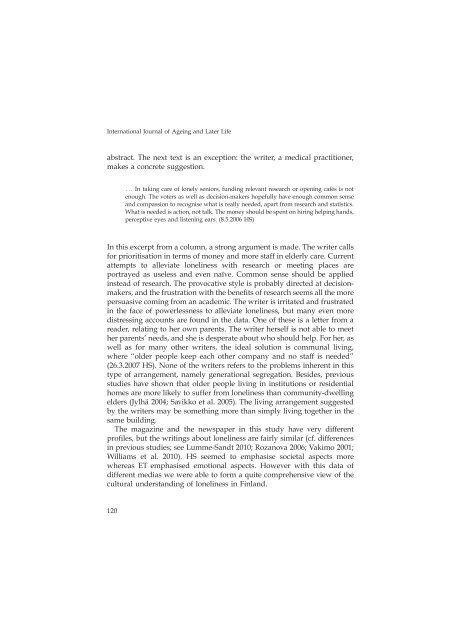Avaa tiedosto - TamPub - Tampereen yliopisto
Avaa tiedosto - TamPub - Tampereen yliopisto
Avaa tiedosto - TamPub - Tampereen yliopisto
Create successful ePaper yourself
Turn your PDF publications into a flip-book with our unique Google optimized e-Paper software.
International Journal of Ageing and Later Life<br />
abstract. The next text is an exception: the writer, a medical practitioner,<br />
makes a concrete suggestion.<br />
... In taking care of lonely seniors, funding relevant research or opening cafés is not<br />
enough. The voters as well as decision-makers hopefully have enough common sense<br />
and compassion to recognise what is really needed, apart from research and statistics.<br />
What is needed is action, not talk. The money should be spent on hiring helping hands,<br />
perceptive eyes and listening ears. (8.5.2006 HS)<br />
In this excerpt from a column, a strong argument is made. The writer calls<br />
for prioritisation in terms of money and more staff in elderly care. Current<br />
attempts to alleviate loneliness with research or meeting places are<br />
portrayed as useless and even naïve. Common sense should be applied<br />
instead of research. The provocative style is probably directed at decisionmakers,<br />
and the frustration with the benefits of research seems all the more<br />
persuasive coming from an academic. The writer is irritated and frustrated<br />
in the face of powerlessness to alleviate loneliness, but many even more<br />
distressing accounts are found in the data. One of these is a letter from a<br />
reader, relating to her own parents. The writer herself is not able to meet<br />
her parents’ needs, and she is desperate about who should help. For her, as<br />
well as for many other writers, the ideal solution is communal living,<br />
where ‘‘older people keep each other company and no staff is needed’’<br />
(26.3.2007 HS). None of the writers refers to the problems inherent in this<br />
type of arrangement, namely generational segregation. Besides, previous<br />
studies have shown that older people living in institutions or residential<br />
homes are more likely to suffer from loneliness than community-dwelling<br />
elders (Jylhä 2004; Savikko et al. 2005). The living arrangement suggested<br />
by the writers may be something more than simply living together in the<br />
same building.<br />
The magazine and the newspaper in this study have very different<br />
profiles, but the writings about loneliness are fairly similar (cf. differences<br />
in previous studies; see Lumme-Sandt 2010; Rozanova 2006; Vakimo 2001;<br />
Williams et al. 2010). HS seemed to emphasise societal aspects more<br />
whereas ET emphasised emotional aspects. However with this data of<br />
different medias we were able to form a quite comprehensive view of the<br />
cultural understanding of loneliness in Finland.<br />
120














